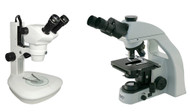Difference Between Compound & Dissecting Microscopes
Mar 19th 2024
Microscopes play a crucial role in scientific research, allowing scientists to observe objects and organisms at the microscopic level. Two common types of microscopes used in laboratories and educational settings are compound microscopes and dissecting microscopes. While both serve the purpose of magnifying objects for observation, they differ in their design, applications, and functionalities.
Dissecting Microscope Uses
Dissecting microscopes, also known as stereo microscopes, are widely used for examining larger, opaque specimens that require low magnification. These microscopes are ideal for tasks such as dissecting biological specimens, examining minerals, inspecting circuit boards, and conducting quality control inspections in industries.
Parts of a Dissecting Microscope
Dissecting microscopes consist of two separate optical paths with eyepieces and objective lenses that provide a three-dimensional (3D) view of the specimen. They typically feature a zoom knob to adjust magnification, a focus knob for precise focusing, and an adjustable light source for illumination.
Dissecting Microscope Applications
The versatility of dissecting microscopes makes them suitable for various applications across different fields. In biology, they are used for studying plant and animal anatomy, conducting dissections, and examining specimens in environmental science. In industries such as electronics and manufacturing, dissecting microscopes are employed for inspecting small components and conducting quality control checks.
Compound Microscope Uses
Compound microscopes, on the other hand, are designed for observing small, transparent specimens at high magnification. These microscopes use multiple lenses to magnify the image of the specimen, allowing for detailed examination of cellular structures, microorganisms, and histological samples.
Parts of a Compound Microscope
Compound microscopes consist of a single optical path with two sets of lenses: the objective lens located near the specimen and the eyepiece lens positioned near the observer's eye. They also feature a stage where the specimen is placed, a focus mechanism for adjusting the clarity of the image, and an illumination system typically located beneath the stage.
Compound Microscope Applications
Compound microscopes are widely used in fields such as biology, medicine, and materials science for a variety of applications. In biology, they are essential for studying cell structures, observing microorganisms, and analyzing tissue samples. In medicine, compound microscopes are used for diagnosing diseases, examining blood samples, and conducting research in fields like microbiology and pathology.
Compound vs. Dissecting Microscope Differences
The primary differences between compound microscopes and dissecting microscopes lie in their design, magnification capabilities, and intended applications. Compound microscopes are designed for observing small, transparent specimens at high magnification, whereas dissecting microscopes are used for examining larger, opaque specimens at low magnification. Additionally, compound microscopes provide a two-dimensional (2D) view of the specimen, while dissecting microscopes offer a three-dimensional (3D) view. Overall, the choice between a compound and dissecting microscope depends on the specific requirements of the observation task and the nature of the specimen being studied.
View our Dissecting Microscopes
View our Compound Microscopes





